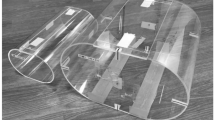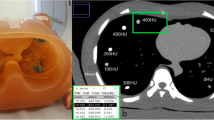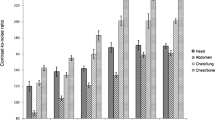Abstract
This study aimed to evaluate the dose reduction potential of adding a tin filter to localizer radiographs (LR) on computed tomography (CT) examinations in both phantom and clinical studies. LRs were performed using combinations of 120 kVp and 20 mA (120/20), 100 kVp with a tin filter, and 50 mA or 20 mA (Sn100/50, Sn100/20). For the phantom experiment, entrance surface doses (ESD) of the LRs were evaluated for each protocol using an anthropomorphic phantom. This retrospective clinical study included 700 patients (300 for chest–pelvis, 200 for spine, and 200 for head CTs). The volume CT dose indices (CTDIvols) of the main CT scans were recorded and placed into one of three groups based on body mass index (BMI): underweight, normal-weight, and overweight, to evaluate the effect of LR acquisition conditions on the performance of the automatic tube current modulation technique of subsequent CT scans. The ESDs of all LRs with the Sn100/50 protocol were 0.03 mGy, a decrease of more than 80% compared to those of the 120/20 protocol. Moreover, the Sn100/20 protocol reduced ESD to 0.02 mGy. In chest–pelvis CT, there were no significant differences in the CTDIvol between with and without a tin filter for each BMI group. However, the lateral LRs with the tin filter on the spine CT slightly reduced the CTDIvol in normal-weight and overweight patients. Although there is room to optimize the acquisition conditions for larger patients, an additional tin filter for LR is a useful means to efficiently reduce ESDs.







Similar content being viewed by others
References
Meinel FG, Canstein C, Schoepf UJ, et al. Image quality and radiation dose of low tube voltage 3rd generation dual-source coronary CT angiography in obese patients: a phantom study. Eur Radiol. 2014;24:1643–50.
Wuest W, May M, Saake M, et al. Low-dose CT of the paranasal sinuses: minimizing x-ray exposure with spectral shaping. Eur Radiol. 2016;26:4155–61.
Gordic S, Morsbach F, Schmidt B, et al. Ultaralow-dose chest computed tomography for pulmonary nodule detection. Invest Radiol. 2014;49:465–73.
Haubenreisser H, Meyer M, Sudarski S, et al. Unenhanced third-generation dual-source chest CT using a tin filter for spectral shaping at 100 kVp. Eur J Radiol. 2015;84(8):1608–13.
Schmidt BT, Hupfer M, Saltybaeva N, et al. Dose optimization for computed tomography localizer radiographs for low-dose lung computed tomography examinations. Invest Radiol. 2017;52:81–6.
Daniel JC, Stevens DM, Cody DD. Reducing radiation exposure from survey CT scans. Am J Radiol. 2005;185:509–15.
Sato T, Kikuchi Y, Nakamura M, et al. Radiation exposure in computed tomography localizer radiograph. Jpn J Radiol Technol. 2019;75(12):1403–10.
Nowik P, Poludniowski G, Svensson A, et al. The synthetic localizer radiograph – a new CT scan planning method. Phys Med. 2019;61:58–63.
Perisinakis K, Damilakis J, Voloudaki A, et al. Patient dose reduction in CT examinations by optimising scanogram acquisition. Radiat Prot Dosim. 2001;93:173–8.
Nauer CB, Kellner-Weldon F, Von Allmen G, et al. Effective doses from scan projection radiographs of the head: impact of different scanning practices and comparison with conventional radiography. Am J Neuroradiol. 2009;30:155–9.
Boher E, Schafer S, Mader U, et al. Optimizing radiation exposure for CT localizer radiographs. Z Med Phys. 2017;27:145–58.
Saltybaeva N, Krauss A, Alkadhi H. Technical note: radiation dose reduction from computed tomography localizer radiographs using a tin spectral shaping filter. Med Phys. 2019;46(2):544–9.
Allmendinger T, Hamann A. Calcium scoring using tin filter spectral shaping a demonstration of Agatston equivalence. Siemens Healthcare GmbH. 2017. https://marketing.webassets.siemens-healthineers.com/1800000006813010/4de284a59358/siemens-healthineers-ct-somatom-drive-cascoring-tinfilter-white-paper_1800000006813010.pdf. Accessed 19 Dec 2022.
Woods M, Brehm M. Shaping the beam: Versatile filtration for unique diagnostic potential within Siemens Healthineers CT. Siemens Healthcare GmbH. 2019. https://cdn0.scrvt.com/39b415fb07de4d9656c7b516d8e2d907/1800000006857523/27030c03dfe2/siemens-healthineers-ct-technologies-and-innovations-tin-filter-whitepaper_v2_1800000006857523.pdf. Accessed 19 Dec 2022.
Takegami K, Hayashi H, Yamada K, et al. Entrance surface dose measurements using a small OSL dosimeter with a computed tomography scanner having 320 rows of detectors. Radiol Phys Technol. 2017;10:49–59.
Takegami K, Hayashi H, Asahara T, et al. Dose calibration factor of an OSL dosimeter during CT examination to measure expose dose of patients taking into consideration proper X-ray quality. Eur Congress Radiol. 2020;11:01393.
Schmidt B, Saltybaeva N, Kolditz D, et al. Assessment of patient dose from CT localizer radiographs. Med Phys. 2013;40(8): 084301.
Frank C, Bacher K. Influence of localizer and scan direction on the dose-reducing effect of automatic tube current modulation in computed tomography. Radiat Prot Dosim. 2016;169:136–42.
Brisse HJ, Ma Dec L, Gaboriaud G, et al. Automatic exposure control in multichannel CT with tube current modulation to achieve a constant level of image noise: experimental assessment on pediatric phantoms. Med Phys. 2007;34(7):3018–33.
Acknowledgements
We would like to thank Mr. Steven Gardner for his advice on preparing our manuscript.
Author information
Authors and Affiliations
Corresponding author
Ethics declarations
Conflict of interest
All the authors declare that they have no conflict of interest.
Ethical approval
All the procedures performed in this study involving human participants were in accordance with the ethical standards of Institutional Review Board and with the 1964 Helsinki Declaration and its later amendments or comparable ethical standards. For this type of study, formal consent was not required at our institution.
Additional information
Publisher's Note
Springer Nature remains neutral with regard to jurisdictional claims in published maps and institutional affiliations.
About this article
Cite this article
Takemitsu, M., Takegami, K., Kudomi, S. et al. Patient dose reduction for a localizer radiograph with an additional tin filter in chest–abdomen–pelvis, spine, and head computed tomography examinations. Radiol Phys Technol 16, 160–167 (2023). https://doi.org/10.1007/s12194-023-00701-w
Received:
Revised:
Accepted:
Published:
Issue Date:
DOI: https://doi.org/10.1007/s12194-023-00701-w




